Primary site and regional lymph node involvement are independent prognostic factors for early-stage extranodal nasal-type natural killer/T cell lymphoma
- PMID: 27044275
- PMCID: PMC4820898
- DOI: 10.1186/s40880-016-0096-0
Primary site and regional lymph node involvement are independent prognostic factors for early-stage extranodal nasal-type natural killer/T cell lymphoma
Abstract
Background: Nasal-type extranodal natural killer/T-cell lymphoma (ENKTCL) originates primarily in the nasal cavity or extra-nasal sites within the upper aerodigestive tract. However, it is unclear whether the primary site can serve as an independent prognostic factor or whether the varying clinical outcomes observed with different primary sites can be attributed merely to their propensities of regional lymph node involvement. The aim of this study was to investigate the prognostic implications of the primary site and regional lymph node involvement in patients with early-stage nasal-type ENKTCL.
Methods: To develop a nomogram, we reviewed the clinical data of 215 consecutively diagnosed patients with early-stage nasal-type ENKTCL who were treated in Sun Yat-sen University Cancer Center with chemotherapy and radiotherapy between 2000 and 2011. The predictive accuracy and discriminative ability of the nomogram were determined using a concordance index (C-index) and calibration curve.
Results: The 5-year overall survival (OS) and progression-free survival (PFS) rates of patients with nasal ENKTCL were higher than those of patients with extra-nasal ENKTCL (OS: 68.2% vs. 46.0%, P = 0.030; PFS: 53.4% vs. 26.6%, P = 0.010). The 5-year OS and PFS rates of patients with Ann Arbor stage IE ENKTCL were higher than those of patients with Ann Arbor stage IIE ENKTCL (OS: 66.3% vs. 59.2%, P = 0.003; PFS: 51.4% vs. 40.3%, P = 0.009). Multivariate analysis showed that age >60 years, ECOG performance status score ≥2, elevated lactate dehydrogenase (LDH) level, extra-nasal primary site, and regional lymph node involvement were significantly associated with lower 5-year OS rate; age >60 years, elevated LDH level, extra-nasal primary site, and regional lymph node involvement were significantly associated with lower 5-year PFS rate. The nomogram included the primary site and regional lymph node involvement based on multivariate analysis. The calibration curve showed good agreement between the predicted and actual 5-year OS and PFS rates, and the C-indexes of the nomogram for the OS and PFS rates were 0.697 and 0.634, respectively.
Conclusions: The primary site and regional lymph node involvement are independent prognostic factors for early-stage ENKTCL treated with chemotherapy followed by definitive radiotherapy.
Keywords: Extranodal natural killer/T-cell lymphoma (ENKTCL); Lymph node; Nasal cavity; Nomogram; Prognosis.
Figures
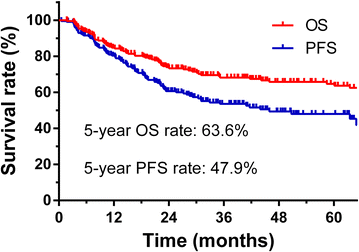
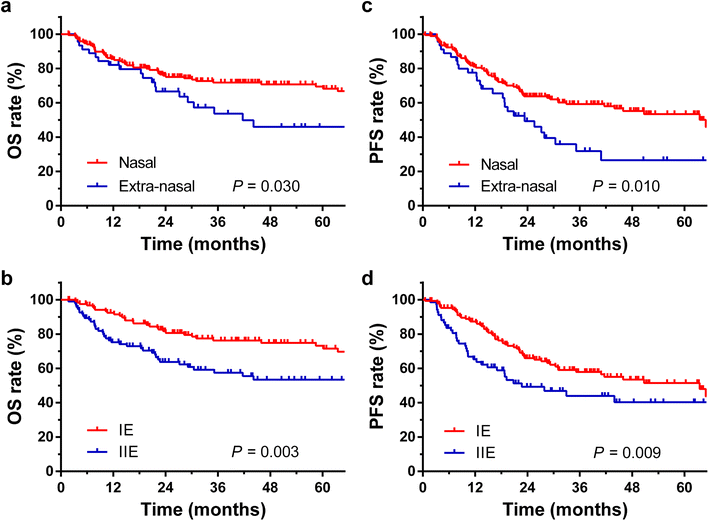
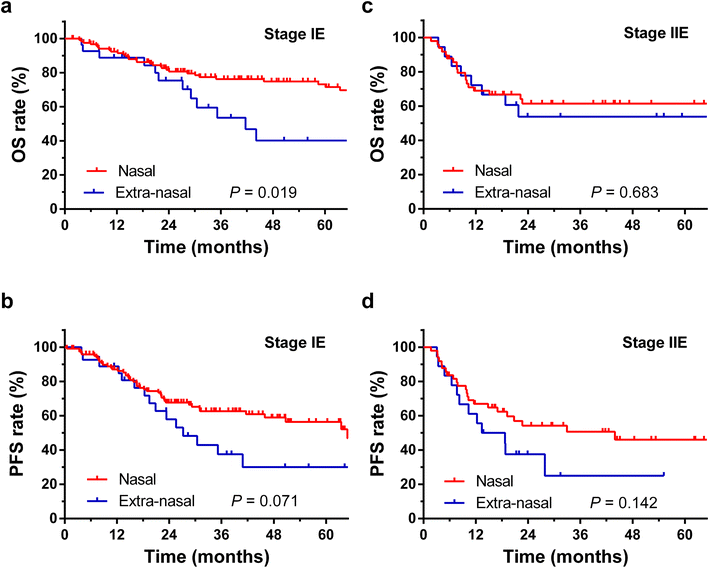
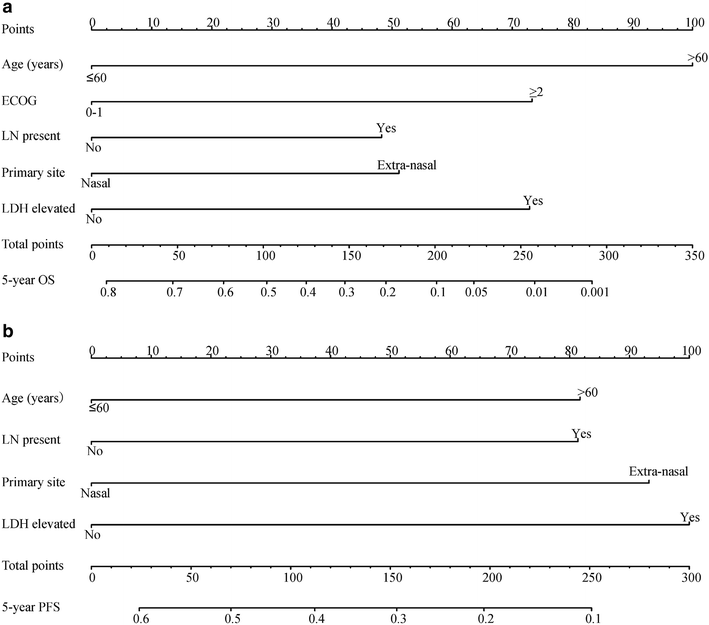
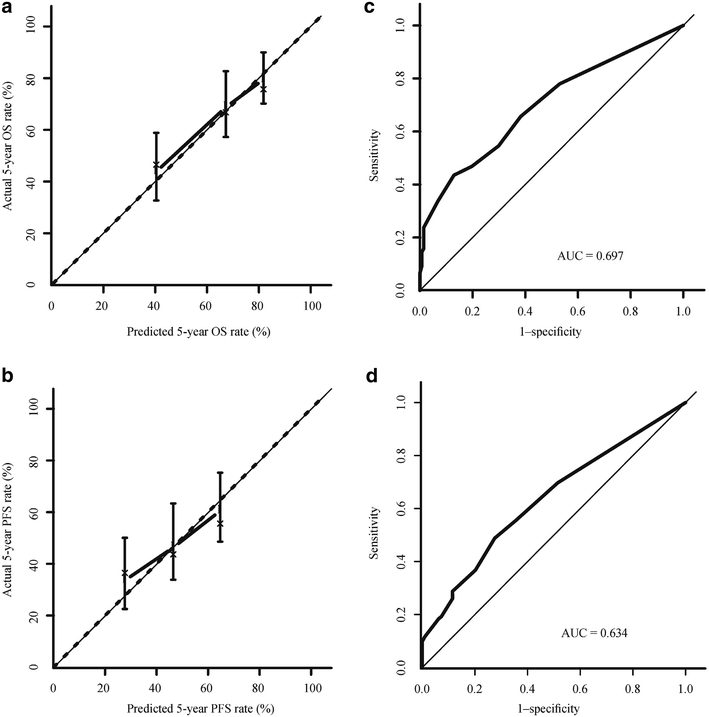
Similar articles
-
[Prognostic factors of primary non-Hodgkin's lymphoma of the nasal cavity--a report of 129 cases].Ai Zheng. 2006 Apr;25(4):465-70. Ai Zheng. 2006. PMID: 16613682 Chinese.
-
[CD16 expression is an independent prognostic factor for extranodal NK/T cell lymphoma of nasal type].Zhonghua Bing Li Xue Za Zhi. 2013 Apr;42(4):227-33. doi: 10.3760/cma.j.issn.0529-5807.2013.04.004. Zhonghua Bing Li Xue Za Zhi. 2013. PMID: 23928528 Chinese.
-
Prognostic nomogram for overall survival in previously untreated patients with extranodal NK/T-cell lymphoma, nasal-type: a multicenter study.Leukemia. 2015 Jul;29(7):1571-7. doi: 10.1038/leu.2015.44. Epub 2015 Feb 20. Leukemia. 2015. PMID: 25697894
-
Nasopharyngeal/nasal type NK/T lymphoma: analysis of 23 cases and current review of the literature.Kulak Burun Bogaz Ihtis Derg. 2012 Sep-Oct;22(5):275-83. doi: 10.5606/kbbihtisas.2012.053. Kulak Burun Bogaz Ihtis Derg. 2012. PMID: 22991988 Review.
-
Extranodal NK/T-cell lymphoma, nasal type, with extranasal presentation - a case report and a review of the literature.Acta Oncol. 2020 Dec;59(12):1480-1487. doi: 10.1080/0284186X.2020.1795250. Epub 2020 Jul 20. Acta Oncol. 2020. PMID: 32689856 Review.
Cited by
-
CD30 expression in extranodal natural killer/T-cell lymphoma, nasal type among 622 cases of mature T-cell and natural killer-cell lymphoma at a single institution in South China.Chin J Cancer. 2017 May 10;36(1):43. doi: 10.1186/s40880-017-0212-9. Chin J Cancer. 2017. PMID: 28486951 Free PMC article.
-
Radiotherapy improves survival in early stage extranodal natural killer/T cell lymphoma patients receiving asparaginase-based chemotherapy.Oncotarget. 2017 Feb 14;8(7):11480-11488. doi: 10.18632/oncotarget.14006. Oncotarget. 2017. PMID: 28002792 Free PMC article.
-
Survival trends for extranodal NK/T-cell lymphoma, nasal type from different anatomical sites: a population-based study.Ann Transl Med. 2021 May;9(10):849. doi: 10.21037/atm-21-1748. Ann Transl Med. 2021. PMID: 34164483 Free PMC article.
-
Prognostic role of ABO blood type in patients with extranodal natural killer/T cell lymphoma, nasal type: a triple-center study.Chin J Cancer. 2017 Jul 31;36(1):62. doi: 10.1186/s40880-017-0229-0. Chin J Cancer. 2017. PMID: 28756771 Free PMC article.
-
High C-Reactive Protein to Albumin Ratio Predicts Inferior Clinical Outcomes in Extranodal Natural Killer T-Cell Lymphoma.Dose Response. 2020 Apr 7;18(2):1559325820917824. doi: 10.1177/1559325820917824. eCollection 2020 Apr-Jun. Dose Response. 2020. PMID: 32284703 Free PMC article.
References
-
- Liu QF, Wang WH, Wang SL, Liu YP, Huang WT, Lu N, et al. Immunophenotypic and clinical differences between the nasal and extranasal subtypes of upper aerodigestive tract natural killer/T-cell lymphoma. Int J Radiat Oncol Biol Phys. 2014;88(4):806–813. doi: 10.1016/j.ijrobp.2013.12.005. - DOI - PubMed
-
- Shi Y, Zhou P, Han X, He X, Zhou S, Liu P, et al. Autologous peripheral blood stem cell mobilization following dose-adjusted cyclophosphamide, doxorubicin, vincristine, and prednisolone chemotherapy alone or in combination with rituximab in treating high-risk non-Hodgkin’s lymphoma. Chin J Cancer. 2015;34(3):52. doi: 10.1186/s40880-015-0045-3. - DOI - PMC - PubMed
MeSH terms
LinkOut - more resources
Full Text Sources
Other Literature Sources
Medical

